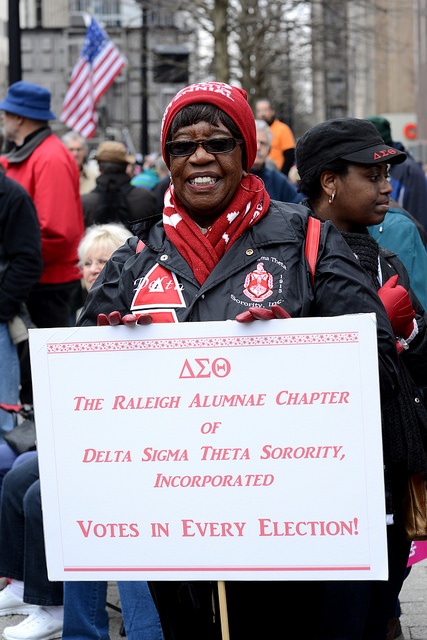The growing power of North Carolina's voters of color

Increases in African-American voter turnout over the past few midterm elections in North Carolina have reduced the white-black voting gap from 10.7 percentage points in 2006 to 4.6 in 2014. (Photo by Stephen Melkesethian via Flickr.)
As 2016 presidential campaigns gear up, political strategists and others are watching the impact of changing voter demographics on election outcomes, particularly in battleground states like North Carolina where there will be showdowns in presidential, Senate, and gubernatorial races. Some, like the Center for American Progress, say the growing number of voters of color has the potential to flip next year's election results in the state.
An Institute analysis of 2014 midterm voters in North Carolina finds that engagement by voters of color has been slowly growing over the past few midterm elections. It should be noted that midterms are a different beast than presidential elections, with significant drops in voter turnout compared to presidential years, particularly among young and non-white voters. But a trend towards increased engagement in these low-turnout years could mean voters of color are poised to hold greater sway in the state in 2016.
In 2014, over 2.9 million voters showed up to the polls in North Carolina, a 44 percent turnout rate. Compared to 2010, all racial demographic groups saw an increase in turnout, with the biggest jumps among voters of color, according to an Institute analysis of North Carolina State Board of Elections data*. From 2010 to 2014, the turnout rate for Asian voters increased by 4 percentage points, for African Americans by almost 2 points, and for Latinos (technically categorized as an ethnicity) by 1.5 percent. White turnout also increased by about 1 percentage point.
While turnout among white voters remained the highest among the groups at 46.8 percent in 2014, the gap in turnout rates between whites and other racial and ethnic groups has been shrinking since 2006. Most dramatically, jumps in African-American turnout over the past few midterms have reduced the white-black gap from 10.7 percentage points in 2006 to 4.6 in 2014.
Gaps in turnout rates between white voters and other voters of color have also narrowed slightly over the past several years, but significant disparities remain between whites and American Indians, Asians, voters of two or more races and Latinos. In North Carolina, the biggest turnout gap has been between white and Latino voters, which actually grew between 2006 and 2014 to 26.3 percentage points. Polling has suggested that President Obama's delay of executive action on immigration may have discouraged Latinos from voting last year.
The number of voters of color going to the polls in midterm elections is also increasing faster than that of white voters. The rate of growth is led by Latinos, whose numbers grew from 15,000 voters in 2010 to over 26,000 in 2014 -- a 74 percent increase. They were followed by Asians with a 71 percent increase, and voters who identify as two or more races with a 54.8 percent jump since 2010. The number of black voters casting ballots also grew, though at the more modest rate of 16.4 percent. White voters saw the slowest growth rate at 5.6 percent, although they made up the largest growth in absolute numbers.
To be sure, the share of 2014 voters who are Latino and Asian remains small at less than 1 percent each. But faster-paced growth among voters of color overall compared to that of whites has resulted in modest but steady growth in the share of voters of color since 2006. That year, voters of color cast 17 percent of ballots; that grew to 22 percent in 2010 and then to nearly 24 percent in the most recent election. Among registered voters, the share of voters of color reached 27 percent in 2014, up from 23 percent in 2006.
By comparison, the share of white voters declined from 81 percent in 2006 to 74 percent in 2014. But thanks to high turnout, white voters were over-represented among voters who went to the polls last fall (74 percent) compared to their share of registered voters in the state (70 percent).
This data show that the voting clout of people of color in North Carolina has grown slowly but steadily over the past three midterm elections. As in other Southern states, the share of North Carolina's electorate who are African-American, Latino, Asian and other non-white races is rising.
What's hard to predict from these midterm numbers is what they mean for turnout in 2016. While participation among voters of color has increased in recent midterms, the turnout disparity -- especially between whites and emerging Latino and Asian populations -- is significant, suggesting there's still great potential to engage these demographics in 2016 and beyond.
* This analysis drew on data current as of December 2014.
Tags
Allie Yee
Allie is a research fellow at the Institute for Southern Studies and is currently studying at the Yale School of Management. Her research focuses on demographic change, immigration, voting and civic engagement.
